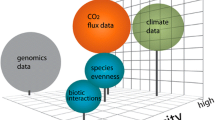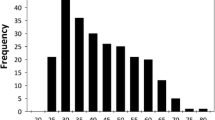Abstract
Ecosystem ecologists are being challenged to address the increasingly complex problems that comprise Big Science. These problems include multiple levels of biological organization that cross multiple interacting temporal and spatial scales, from individual plants, animals, and microbes to landscapes, continents, and the globe. As technology improves, the availability of data, derived data products, and information to address these complex problems are increasing at finer and coarser scales of resolution, and legacy, dark data are brought to light. Data analytics are improving as big data increase in importance in other fields that are improving access to these data. New data sources (crowdsourcing, social media) and ease of communication and collaboration among ecosystem ecologists and other disciplines are increasingly possible via the internet. It is increasingly important that ecosystem ecologists be able to communicate their findings, and to translate their concepts and findings into concrete bits of information that a general public can understand. Traditional approaches that portray ecosystem sciences as a dichotomy between empirical research and theoretical research will keep the field from fully contributing to the complexity of global change questions, and will keep ecosystem ecologists from taking full advantage of the data and technology available. Building on previous research, we describe a more forward-looking, integrated empirical–theoretical modeling approach that is iterative with learning to take advantage of the elements of Big Science. We suggest that training ecosystem ecologists in this integrated approach will be critical to addressing complex Earth system science questions, now and in the future.


Similar content being viewed by others
References
Aceves-Bueno E, Adeleye AS, Bradley D, Brandt WT, Callery P, Feraud M, Garner KL, Gentry R, Huang McCullough I, Pearlman I, Sutherland SA, Wilkinson W, Yang Y, Zink T, Anderson SE, Tague C. 2015. Citizen science as an approach for overcoming insufficient monitoring and inadequate stakeholder buy-in in adaptive management: criteria and evidence. Ecosystems 18:493–506.
Allen CR, Angeler DG, Garmestani AS, Gunderson LH, Holling CS. 2014. Panarchy: theory and application. Ecosystems 17:578–89.
Box GEP, Draper NR. 1987. Empirical model-building and response surfaces. New York: Wiley.
Briske DD, Washington-Allen RA, Johnson CR, Lockwood JA, Lockwood DR, Stringham TK, Shugart HH. (2010). Catastrophic thresholds: a synthesis of concepts, perspectives and applications. Ecol Soc 15: 37. [online] URL: http://www.ecologyandsociety.org/vol15/iss3/art37/.
Carney KM, Matson PA. 2005. Plant communities, soil microorganisms, and soil carbon cycling: does altering the world belowground matter to ecosystem functioning? Ecosystems 8:928–40.
Chen C, Cleverly J, Zhang L, Yu Q, Eamus D. 2016. Modelling seasonal and inter-annual variations in carbon and water fluxes in an Arid-Zone Acacia Savanna Woodland, 1981–2012. Ecosystems 19:625–44.
Collins SM, Sparks JP, Thomas SA, Wheatley SA, Flecker AS. 2016. Stable isotope for bacteria use of carbon in streams. Ecosystems 19:396–410.
Foley JA, Coe MT, Scheffer M, Wang G. 2003. Regime shifts in the Sahara and Sahel: interactions between ecological and climatic systems in northern Africa. Ecosystems 6:524–39.
Groffman PM, Rustad LE, Templer PH, Campbell JL, Christenson LM, Lany NK, Socci AM, Vadeboncoeur MA, Schaberg PG, Wilson GF, Driscoll CT, Fahey TJ, Fisk MC, Goodale CL, Green MB, Hamburg SP, Johnson CE, Mitchell MJ, Morse JL, Pardo LH, Rodenhouse NL. 2012. Long-term integrated studies show complex and surprising effects of climate change in the northern hardwood forest. Bioscience 62:1056–66.
Ives AR, Turner MG, Pearson SM. 1998. Local explanations of landscape patterns: can analytical approaches approximate simulation models of spatial processes? Ecosystems 1:35–51.
Julian JP, Stanley EH, Doyle MW. 2008. Basin-scale consequences of agricultural land use on benthic light availability and primary production along a sixth-order temperature river. Ecosystems 11:1091–105.
Kim SL, Shuman BN, Minckley TN, Marsicek JP. 2016. Biogeochemical change during climate-driven afforestation: a paleoecological perspective from the Rocky Mountains. Ecosystems 19:615–24.
Lockwood JA, Lockwood DR. 1993. Catastrophe theory: a unified paradigm for rangeland ecosystem dynamics. J Rang Manag 46:282–8.
Okin GS, Gu J. 2015. The impact of atmospheric conditions and instrument noise on atmospheric correction and spectral mixture analysis of multispectral imagery. Remote Sens Environ 164:130–41.
Oreskes N, Conway E. 2010. Merchants of doubt: how a handful of scientists obscured the truth on issues from tobacco smoke to global warming. New York: Bloomsbury Press.
Peters DPC, Bestelmeyer BT, Turner MG. 2007. Cross-scale interactions and changing pattern-process relationships: consequences for system dynamics. Ecosystems 10:790–6.
Peters DPC, Belnap J, Collins SL, Ludwig J, Paruelo J, Hoffman T. 2012. How can science be general yet specific: the conundrum of rangelands science in the 21st century. Rangel Ecol Manag 65:613–22.
Peters DPC, Groffman PM, Nadelhoffer KJ, Grimm NB, Collins SL, Michener WK, Huston MA. 2008. Living in an increasingly connected world: a framework for continental-scale environmental science. Front Ecol Environ 5:229–37.
Peters DPC, Havstad KM, Archer SR, Sala OE. 2015. Beyond desertification: new paradigms for dryland landscapes. Front Ecol Environ 1:4–12.
Peters DPC, Havstad KM, Cushing J, Tweedie CE, Fuentes O, Villanueva-Rosales N (2014a). Harnessing the power of big data: infusing the scientific method with machine learning to transform ecology. Ecosphere 5: art6. 10.1890/ES13-00359.1.
Peters DPC, Loescher HW, SanClements MD, Havstad KM. 2014b. Taking the pulse of a continent: building on site-based research infrastructure for regional-to continental-scale ecology. Ecosphere . doi:10.1890/ES13-00359.1.
Preston DL, Mischler JA, Townsend AR, Johnson PTJ. 2016. Disease ecology meets ecosystem science. Ecosystems 19:737–48.
Rietkerk M, Dekker SC, deRuiter PC, van de Koppel J. 2004. Self-organized patchiness and catastrophic shifts in ecosystems. Science 305:1926–9.
Schmitz OJ, Raymond PA, Estes JA, Kurz WA, Holtgrieve GW, Ritchie ME, Schindler DE, Spivak AC, Wilson RW, Bradford MA, Christensen V, Deegan L, Smetacek V, Vanni MJ, Wilmers CC. 2014. Animating the carbon cycle. Ecosystems 17:344–59.
Silberzahn R, Uhlmann EL. 2015. Many hands make tight work. Nature 526:189–91.
Treasure AM, Ruzicka JJ, Moloney CL, Gurney LJ, Ansorge IJ. 2015. Land-sea interactions and consequences for sub-antarctic marine food webs. Ecosystems 18:752–68.
Zinnert JC, Shiflett SA, Via S, Bissett S, Dows B, Manley P, Young DR. 2016. Spatial–temporal dynamics in barrier island upland vegetation: the overlooked coastal landscape. Ecosystems 19:685–97.
Acknowledgements
The authors thank Monica Turner and Steve Carpenter for inviting us to contribute to this special issue, and for helpful comments on a previous version. Funding was provided by National Science Foundation awards (DEB-1235828) and (DEB-1440166) to New Mexico State University in support of the Jornada Basin Long Term Ecological Research Program.
Author information
Authors and Affiliations
Corresponding author
Additional information
Author Contributions
Debra P.C. Peters and Gregory S. Okin contributed to the ideas and writing of this manuscript.
Rights and permissions
About this article
Cite this article
Peters, D.P., Okin, G.S. A Toolkit for Ecosystem Ecologists in the Time of Big Science. Ecosystems 20, 259–266 (2017). https://doi.org/10.1007/s10021-016-0072-1
Received:
Accepted:
Published:
Issue Date:
DOI: https://doi.org/10.1007/s10021-016-0072-1




